Haryana State Board HBSE 10th Class Science Notes Chapter 10 Light Reflection and Refraction Notes.
Haryana Board 10th Class Science Notes Chapter 10 Light Reflection and Refraction
Light:
- When light falls on an object let us say a book, or a table, etc., it gets reflected, The reflected light rays reach our eyes and enable us to see the object.
- Light waves do not require a material medium (like solid, liquid or gas) for their propagation and hence are called non-mechanical waves.
- When light is incident on a surface separating two medias such as air and water, then some part of incident light is reflected, some part is transmitted and some part of it is absorbed by that surface.
Reflection of Light
Reflection :
The phenomenon of sending back the light rays which fall on the surface of an object when light is incident on it, is called reflection of light.
Types:
- Regular reflection and
- Irregular (diffused) reflection
![]()
Image:
When a number of rays emerging from a point of an object, after reflection or refraction, ‘meet’ or ‘appear to meet’ at another point, then the point of meeting is called the image of the first point.
Types:
- Real image and
- Virtual image
Real Image: When the rays of light after reflection or refraction ‘actually meet’ at a point, the image formed is called a real image.
Virtual Image: When the rays of light after reflection or refraction ‘do not actually meet’ but ‘appear to meet’ at a point, the image formed is called a virtual image.
A polished/shining surface which reflects almost all the light incident on it is called a mirror.
Types of mirror:
(1) Plane mirror and (2) Spherical mirror.
Further, spherical mirrors are of two types. They are: (a) Concave mirror and (b) Convex mirror.
Spherical Mirrors
Plane mirror :
A plane mirror is a thin, flat and smooth sheet of glass having a shining coat of silver metal on one side. For example, mirror used in vehicles,in dressing tables, etc.
Spherical mirror :
Unlike plane mirrors, spherical (curved) mirrors converge or diverge the parallel light rays incident on them.
Concave mirror:
The spherical mirror in which light rays converge to form an image is called a concave mirror (or converging mirror).
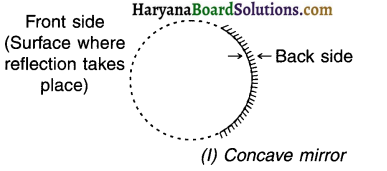
Convex mirror:
A spherical mirror in which light rays diverge to form an image is called a convex mirror (or diverging mirror).
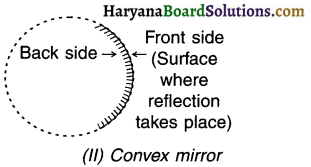
Image Formation by Spherical Mirrors and Representation of Images Formed by Spherical Mirrors Using Ray Diagrams
- The image of an object formed by a spherical mirror (or a lens) can be obtained and studied by constructing a ray diagram.
- Two rays are sufficient to draw a ray diagram because by intersecting two reflected rays we can obtain the position of the image formed.
![]()
Converging (Concave) mirror:
When parallel rays are incident on concave mirror,on reflection, they converge i.e. come closer to each other and meet at a point called principal focus (F). Hence, concave mirror is also called a converging mirror.
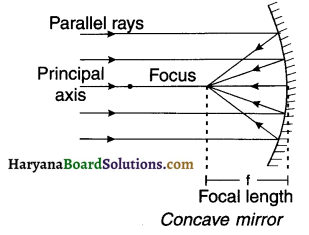
Diverging (Convex) mirror:
When parallel rays are incident on convex mirror, on reflection, they diverge i.e. spread out from each other. Hence, convex mirror is also called a diverging mirror.
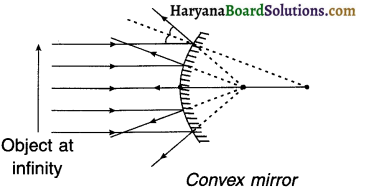
Relation between radius of curvature (R) and focal length (f) of a spherical mirror:
Focal length\((f)=\frac{1}{2} R=\frac{R}{2}\)
Obtaining Images through concave., and convex mirrors
Positions at which we can place an object to obtain images from a concave mirror and summary of the images formed:
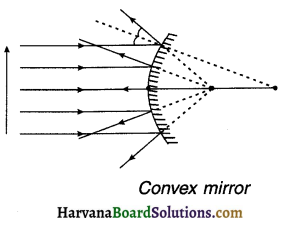
Summary of images formed in a concave mirror
| Position of object | Position of Image | Size of image | Nature of Image |
| 1. At infinity 2. Beyond C(i.e. 2F) 3. On C (i.e. on 2F) 4. Between F and C 5. On principal focus F 6. Between P and F |
At F Between F and C On C Beyond C At infinity Behind the mirror |
Highly diminished Diminisified Same as object size Enlarged Highly enlarged Enlarged |
Real and inverted Real and inverted Real and inverted Real and inverted Real and inverted Virtual and erect |
![]()
Positions at which we can place an object to obtain Images from a convex mirror and summary of the images formed:

Summary of images formed in a convex mirror
| Position of object | Position of image | Size of image | Nature of image |
| 1. At infinity
2. Anywhere between infinity and pole P of the mirror |
At focus F, behind the mirror
Between pole P and focus F, behind the mirror |
Highly diminished
Diminished |
Virtual and erect
Virtual and erect |
Sign Convention for Reflection by Spherical Mirrors
Summary of New Cartesian Sign Convention for reflection by spherical mirror:

Mirror Formula and Magnification :
- The relationship between the object distance (u), image distance (v) and focal length (f) of a mirror is called the mirror formula.
As per mirror formula:\(\frac{1}{u}+\frac{1}{v}=\frac{1}{f}\) - The ratio of image height (h’) to object height (h) is called the magnification (m).
Thus, for spherical mirrors, magnification \((m)=\frac{\text { Height of image }\left(h^{\prime}\right)}{\text { Height of object }(h)} \quad \text { i.e. } m=\frac{h^{\prime}}{h}\) - In terms of object distance (u) and image distance (y), magnification (m) can be expressed as, \(m=\frac{h^{\prime}}{h}=-\frac{v}{u}\)
![]()
Summary of size of image, type of image and magnification for various mirrors
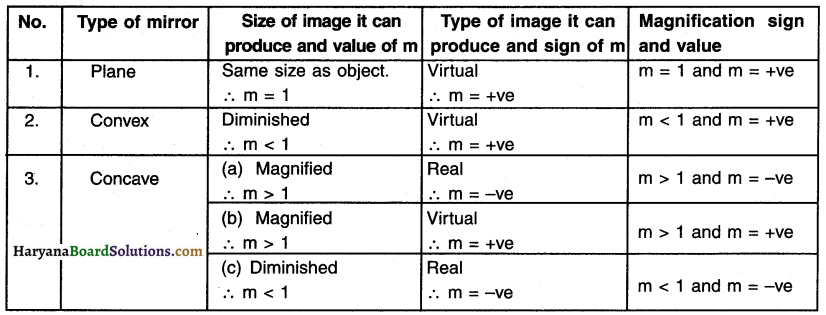
Refraction of Light
Refraction:
When a ray of light enters obliquely from one transparent medium to another transparent medium, its velocity changes due to which it gets deviated from its original direction at the surface separating two medias. This is called refraction.

Medium:
A transparent substance in which light can travel is called a medium. Air, water, gas, glass, kerosene, etc. are examples of mediums.
- Optically rarer medium: A medium in which the speed of light is more is called optically rarer medium. For example, air.
- Optically denser medium: A medium in which the speed of light is less (compared to optically rarer medium) is called an optically denser medium. For example glass and water (in comparison to air).
Relative Refractive index :
- The ratio of speed of light v1 in medium 1 to the speed of light v2 in medium 2 is known as the relative refractive index of medium 2 with respect to medium 1 (except the medium of vacuum).
- It is denoted by η21 i.e. refractive index of medium 2 with respect to medium 1.
∴ Refractive index \(\eta_{21}=\frac{\text { Speed of light in medium } 1}{\text { Speed of light in medium } 2}=\frac{v_1}{v_2}\)
Moreover, Absolute refractive index \(\eta_{\mathrm{m}}=\frac{\text { Speed of light in vacuum }}{\text { Speed of light in medium }}=\frac{\mathrm{c}}{\mathrm{v}}\)
![]()
Snell’s law:
The ratio of sine of angle of incidence to the ratio of sine of angle of refraction is constant.
∴ \(\eta_{21}=\frac{\sin \theta_1}{\sin \theta_2}\)
Refraction by Spherical Lenses and Formation of Images
Lens: A lens is a piece of transparent glass bound by two spherical surfaces.
Types: Convex (Converging) lens:
A lens which is thick at the center and tapered at the upper and lower ends is called a convex lens.
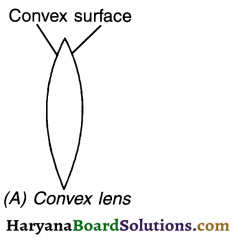
Concave (Diverging) lens:
A lens which is thin in the middle but thicker at the edges is called concave lens.

Positions at Which we can place an object in front of convex lens and the summary of images formed:
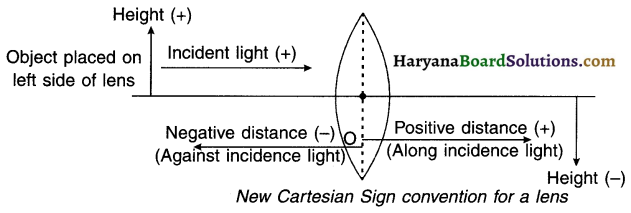
Summary of images formed by convex lens
| No. | Position of the object | Position of the image | Size of image | Nature of image |
| 1 | At infinite distance | On opposite side of lens at F2 | Highly diminished | Real & inverted |
| 2 | Beyond 2F1 | On opposite side of lens between F2 & 2F2 | Diminished | Real & inverted |
| 3 | At 2F1 | On opposite side of lens at 2F2 | Same as object | Real & inverted |
| 4 | Anywhere between F1 & 2F1 |
On opposite side of lens beyond 2F2 | Enlarged | Real & inverted |
| 5 | At F1 | At infinity | Highly enlarged | Real & inverted |
| 6 | Anywhere between O & F1 | On the same side of the lens as the object beyond 2F1 | Enlarged | Virtual & erect |
![]()
Summary of images formed by concave lens
| No. | Position of the Object | Position of the Image | Size of Image | Nature of Image |
| 1. | At infinity | On the same side of a lens as the object at focus F1 | Highly diminished | Virtual & erect |
| 2. | Between O & infinity | On the same side as object between O & focus F1 | Diminished lens as the object | Virtual & erect |
Summary of New Cartesian Sign Convention followed for refraction of light through spherical lenses
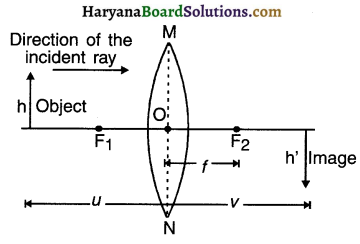
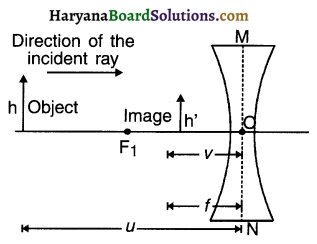
Power of Lens
The power of lens (P) is the “Reciprocal of the focal length (f) of lens”.
∴ Power of lens (P) = \(\frac{1}{f}\)
